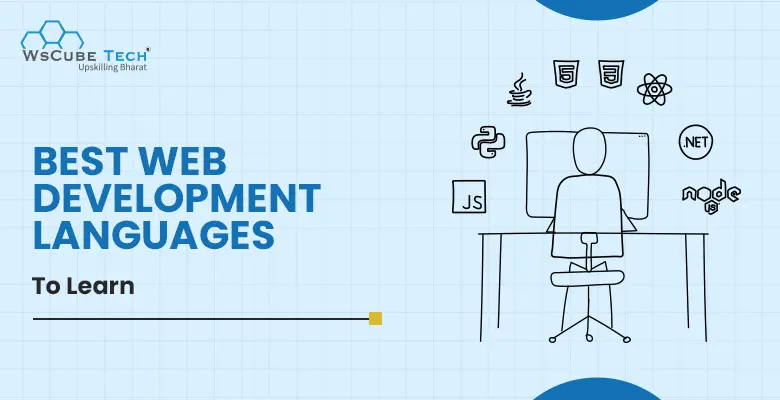Did you know the world’s first programming language was created in 1883? Since then, hundreds of languages have evolved, each with unique syntax, purpose, and features.
Web development languages are the backbone of the internet, powering everything from simple blogs to complex online applications. In today’s fast-paced digital age, staying up-to-date with the most popular web languages and tools is more important than ever.
If you are new to web development, the toughest part of learning programming is deciding where to start. Hundreds of web development languages are widely used, each with complexities and idiosyncrasies.
As you begin the web developer’s journey, the good news is that you will discover which programming language will suit you, your interests, and your career goals. If you are a beginner, you can get started with an online full stack developer course.
This article reviews the most in-demand and best web development languages for many common use cases and career paths.

What is Web Development Language?
A Web Development Language is a programming language used to create and manage websites and web applications. It can be focused on the front-end (client-side), where languages like HTML, CSS, and JavaScript are used to design the look and interactivity of websites. Alternatively, it can be focused on the back-end (server-side), employing languages such as Python, PHP, Ruby, and Java to handle database operations, server configuration, and application logic. These languages enable developers to build everything from simple web pages to complex, dynamic web applications, providing the functionality and aesthetics users interact with on the internet.
Upskill Yourself With Live Training
Types of Web Development Languages
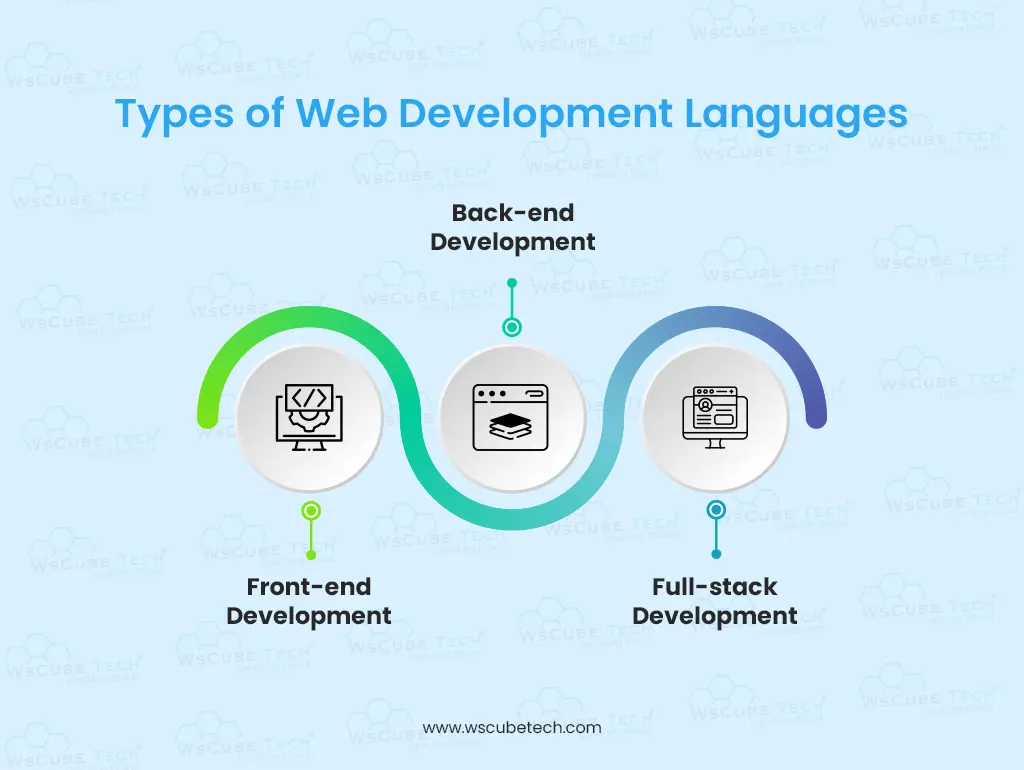
The main types of web development include front-end development and back-end development. Each type focuses on different aspects of creating a website or web application, and they come together to form the complete web development process (called full stack development).
1. Front-end Development (Client-side)
Front-end development involves creating the part of the website that users interact with directly. It’s all about the visuals, layout, and interactivity of a website or web application. Front-end developers use a combination of languages and frameworks to build the user interface and user experience (UI/UX) of a web application.
Languages and Technologies Used:
- HTML (HyperText Markup Language)
- CSS (Cascading Style Sheets)
- JavaScript
- ReactJS
- Angular
- Vue.js
- Bootstrap
- Tailwind CSS
Also Read: Top 100 Web Development Interview Questions and Answers (2025)
2. Back-end Development (Server-side)
Back-end development focuses on the server, database, and application logic—everything that works behind the scenes to power the front-end. Back-end developers ensure that data or services requested by the front-end are delivered through programmatic means. They handle database interactions, server configuration, and implementation of application logic.
Languages and Technologies Used:
- Python
- Ruby
- PHP
- Java
- Node.js
- C#
Databases:
- SQL databases (like MySQL, PostgreSQL)
- NoSQL databases (like MongoDB, Cassandra)
Server Technologies:
- Web servers (Apache, Nginx)
- Cloud computing platforms (AWS, Google Cloud, Azure)
3. Full-stack Development
In addition to front-end and back-end development, there’s also a role that bridges both: full-stack development.
Full-stack developers have the skills to work on both the front-end and back-end parts of a project. They can create a web application from start to finish, handling everything from designing the user interface to server and database management. These developers are in huge demand for their versatility and skills. You can become one with an expert-led online full stack development course.
Best Web Development Languages for Front-end
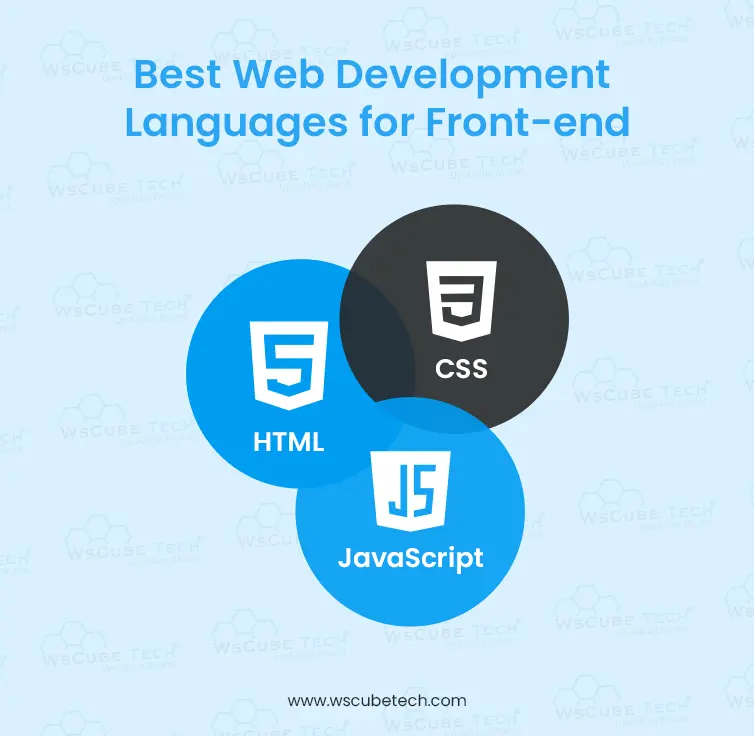
Let’s know about the most popular website development languages used to build the front-end of a website or web app:
1. HTML

HTML, or HyperText Markup Language, is the foundational language of the web. It’s not a programming language in the traditional sense, as it doesn’t contain logic or algorithms, but a markup language that tells web browsers how to structure the content on web pages.
HTML forms the backbone of almost all websites on the internet, making it a crucial skill for anyone looking to enter the field of web development.
HTML’s Role in Front-end Development
HTML is the skeleton of a web page. It provides the basic structure, onto which CSS (Cascading Style Sheets) adds styling, and JavaScript adds interactivity. Every website you visit is built using HTML.
It allows developers to define elements like headings, paragraphs, links, images, and more. Without HTML, web pages would be plain text without any organization or design.
Key Features of HTML
- Simplicity: HTML is easy to learn and use, making it accessible to beginners.
- Flexibility: While HTML itself is static, it can be combined with CSS and JavaScript to create dynamic and interactive web experiences.
- Universality: Every web browser supports HTML, ensuring that content can be viewed consistently across different devices and platforms.
- Structure: HTML allows for the organization of web content in a structured manner, using various tags and attributes to define different content types.
- Accessibility: Proper use of HTML can make web content accessible to people with disabilities, by providing alternative text for images, proper headings structure for screen readers, and more.
Benefits of Using HTML
- Wide Support: HTML is supported by all web browsers, ensuring that websites built with HTML can be accessed by anyone, anywhere.
- SEO Friendly: Correctly structured HTML helps improve website search engine rankings. Search engines rely on HTML structure to understand and index web content.
- Ease of Learning: HTML is considered one of the easiest languages to start with for those new to web development, making it a great first step into the field. You can easily learn it with an online HTML course.
- Open Standard: HTML is developed by the World Wide Web Consortium (W3C), ensuring it remains an open standard that evolves based on the needs of the internet community.
Also Read: 20 Best Web Development Tools in 2025 (Web Dev Tools List)
2. CSS
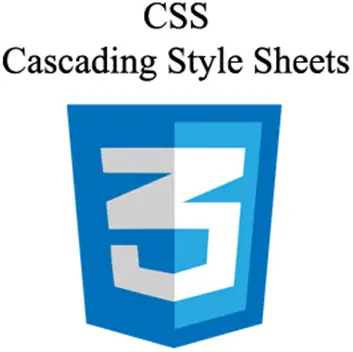
CSS, which stands for Cascading Style Sheets, is a stylesheet language used to describe the presentation of a document written in HTML or XML.
CSS defines how elements should be displayed on the screen, on paper, in speech, or on other media. It’s one of the core technologies of the World Wide Web, alongside HTML and JavaScript, playing a vital role in building visually engaging and user-friendly websites.
CSS’s Role in Front-end Development
While HTML provides the structure of a page, CSS gives it style. CSS controls the layout of multiple web pages all at once. Without CSS, web pages would look plain and unstyled, displaying only the basic content.
CSS allows you to add colors, fonts, spacing, layout designs, and even animations to your web pages, making the web more beautiful and interactive. You can learn this language easily with an online CSS course.
Key Features of CSS
- Separation of Concerns: CSS allows you to separate content from design. This means you can change the look of a website without altering the HTML.
- Cascading and Specificity: CSS rules cascade, which means the styles are applied in order of priority, allowing for flexible and manageable styling strategies.
- Responsive Design: CSS enables the creation of responsive web designs, meaning your site can adjust its layout and appearance based on the size and orientation of the device it’s being viewed on.
- Reusability: Once you define a CSS style, you can reuse it across multiple HTML elements and pages, making it efficient for styling large websites.
Benefits of Using CSS
- Enhanced User Experience: CSS improves the user experience by creating more visually engaging web pages that are easier to navigate and interact with.
- Faster Page Load Times: By separating the content from the design, CSS can reduce file sizes and make web pages load faster.
- Ease of Maintenance: CSS makes it easier to maintain and update the website’s design without touching the content, saving time and effort.
- Cross-Browser Compatibility: With CSS, you can ensure that your website looks consistent across different web browsers and devices.
- Accessibility: Proper use of CSS can improve web accessibility, making your site more usable for people with disabilities.
3. JavaScript

JavaScript is a powerful programming language that runs in the browser and enables developers to make web pages interactive and dynamic. Unlike HTML, which structures content, and CSS, which styles it, JavaScript provides the functionality.
It can be used to create games, apps, manage responsive layouts, and much more, making it an essential tool for front-end web development.
JavaScript’s Role in Front-end Development
JavaScript plays a crucial role in enhancing user experiences by allowing web pages to react to user actions.
It makes it possible to update content dynamically, validate forms, create animations, and handle user interactions without needing to reload the page. JavaScript is the engine behind single-page applications (SPAs) and progressive web apps (PWAs), enabling modern web experiences.
Key Features of JavaScript
- Interactivity: JavaScript allows users to interact with web pages in real-time, improving user engagement and satisfaction.
- Versatility: JavaScript can be used in various environments, not just web browsers, including server-side (Node.js) and mobile app development (React Native).
- Event Handling: JavaScript responds to user actions like clicks, form submissions, and mouse movements, making web pages more dynamic.
- DOM Manipulation: JavaScript can dynamically alter the Document Object Model (DOM), allowing for the addition, removal, and modification of HTML and CSS on the fly.
- Asynchronous Programming: With features like callbacks, promises, and async/await, JavaScript can perform non-blocking operations, such as fetching data from a server, improving page load times.
Benefits of Using JavaScript
- Enhanced User Experience: JavaScript makes web pages more interactive and responsive, leading to a better overall user experience.
- Rich Web Applications: JavaScript enables the development of complex applications like social media platforms, video streaming sites, and online games.
- Universal Language of the Web: JavaScript is supported by all modern web browsers without the need for any plugins, making it universally accessible. Try practicing it with JavaScript programs.
- Large Community and Ecosystem: There’s a vast community of developers and an extensive ecosystem of libraries and frameworks (like React, Angular, and Vue) that make development faster and more efficient.
- Career Opportunities: Knowing JavaScript opens up numerous career opportunities in web development, as it’s one of the most sought-after skills in the industry. Start learning it with an online JavaScript course.
Interview Questions for You to Prepare for Jobs
Best Web Development Languages for Backend
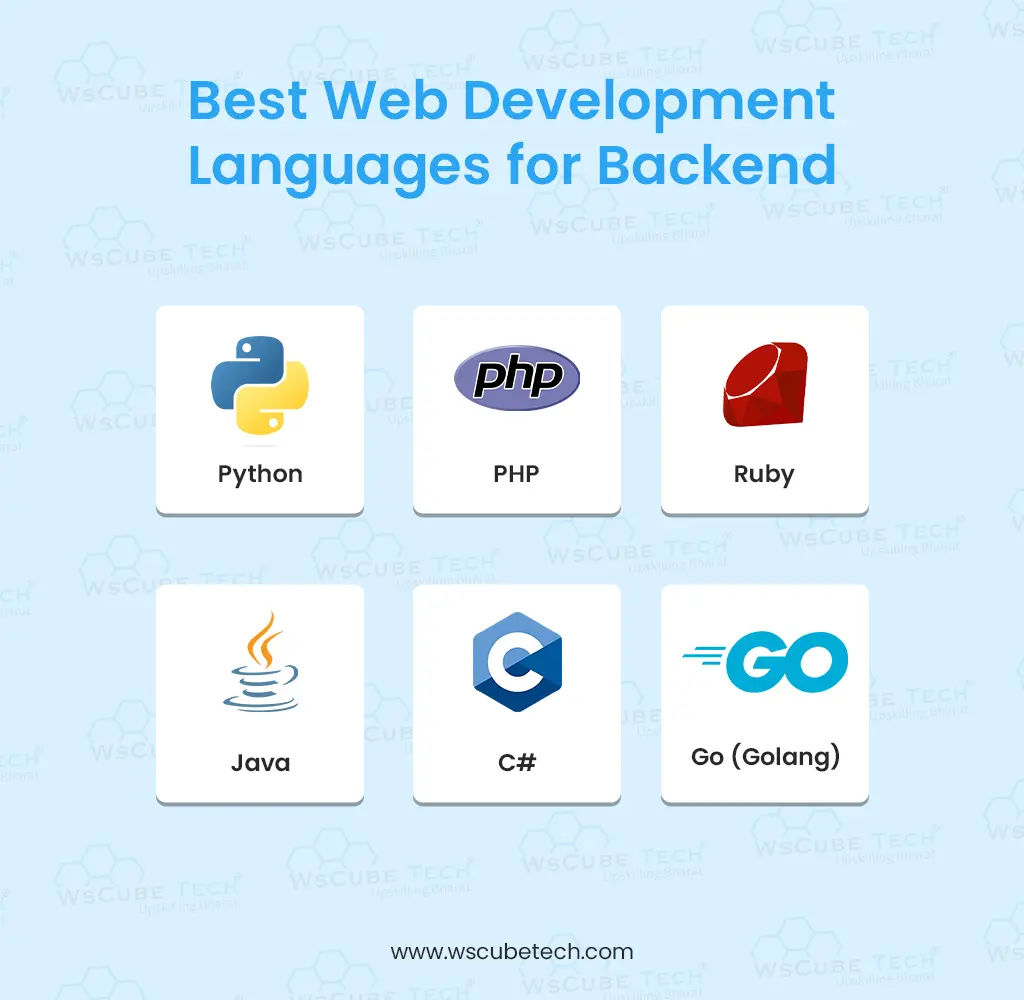
Now, we will talk about the most popular web programming languages used to build the backend of a website or web app:
4. Python
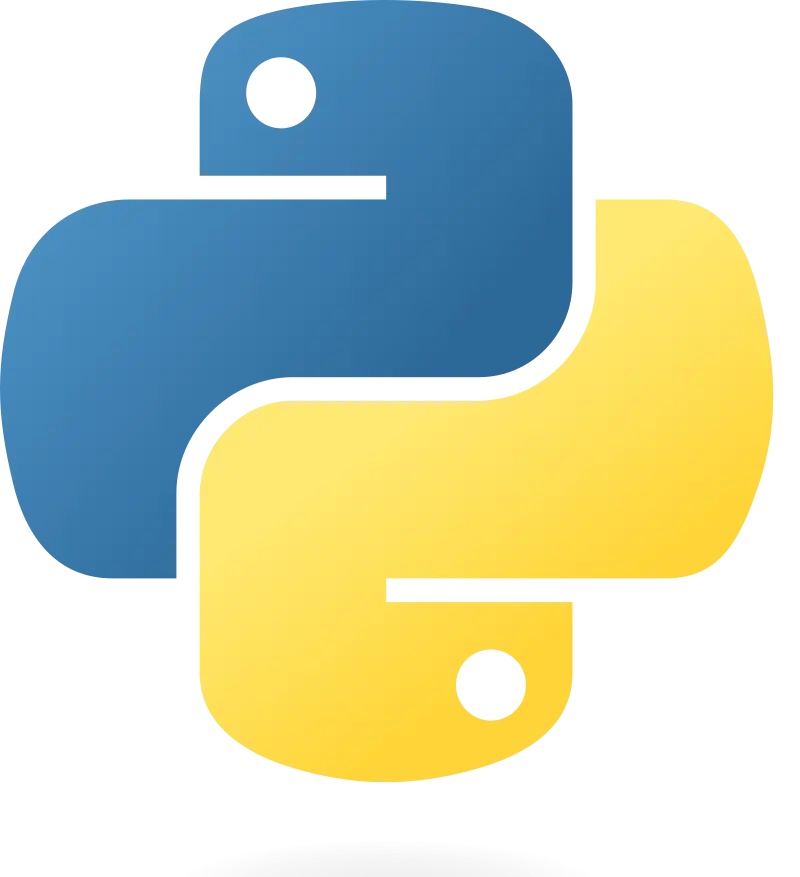
Python is a versatile, high-level programming language known for its simplicity and readability, making it an excellent choice for beginners and experienced developers alike. In web development, Python is predominantly used on the server side, where it handles the logic behind user actions, interacts with databases, and manages data processing.
Python’s Role in Backend Development
As one of the top web development languages, Python serves as the backbone of server-side logic. It runs on the server, processing data, managing database operations, and communicating between the front end and the server.
This includes everything from user authentication to data analysis and serving dynamic content to users. Python’s extensive library ecosystem and frameworks, such as Django and Flask, streamline the development of robust and scalable web applications.
Key Features of Python
- Ease of Learning: Python’s syntax is clear and intuitive, making it an ideal language for beginners to start learning programming. You can master it with an online Python course.
- Versatility: Python can be used for a wide range of applications, from web development to data science and machine learning, allowing developers to transition easily between different fields.
- Rich Ecosystem: Python boasts a vast collection of libraries and frameworks that simplify tasks like web development, data analysis, and more. Django and Flask, for instance, are powerful tools for building web applications.
- Portability: Python code can run on various operating systems without requiring changes, making it a flexible choice for developing cross-platform applications.
- Community Support: With one of the largest programming communities, Python users have access to a wealth of resources, tutorials, and support forums, making problem-solving easier for developers at all levels.
Benefits of Using Python for Backend Development
- Rapid Development: Python’s simplicity and the powerful libraries and frameworks available allow for faster development of web applications, from concept to deployment.
- Scalability: Python applications can be easily scaled to handle large volumes of traffic and data, making it suitable for small projects as well as enterprise-level applications.
- Security: Frameworks like Django come with built-in security features that help protect against common vulnerabilities such as SQL injection, cross-site scripting, and forgery.
- Integration Capabilities: Python can integrate with other languages and technologies, allowing for flexible development environments and the incorporation of existing legacy systems.
- High Demand: Python developers are in high demand in the job market, thanks to the language’s popularity in web development, data science, artificial intelligence, and more.
Also Read: What is Full Stack Development? 2025 Guide
5. PHP

PHP, which stands for Hypertext Preprocessor, is a widely-used open-source scripting language for web development. It can be embedded directly into HTML code, making it particularly suited for creating dynamic web pages. PHP runs on the server side, meaning it executes on the server before the HTML is sent to the client’s browser.
PHP’s Role in Backend Development
PHP’s primary role in web development is on the backend, where it handles server-side tasks like processing form data, managing file uploads, interacting with databases, and generating dynamic content.
It is the server that executes PHP scripts before sending the resulting HTML to the client, allowing for the creation of customized experiences for users based on their interactions. You can master this web development language with an online PHP course.
Key Features of PHP
- Ease of Use: PHP syntax is straightforward for beginners, with a low learning curve, especially for those with basic programming knowledge.
- Cross-Platform: PHP is compatible with almost all operating systems, including Windows, Linux, and macOS, making it highly versatile for web development.
- Database Integration: PHP easily integrates with numerous databases, such as MySQL, making it ideal for developing data-driven websites.
- Rich Ecosystem: There is a vast array of frameworks, such as Laravel and Symfony, and tools available for PHP that speed up the development process and enhance application security and scalability.
- Strong Community Support: With a large and active community, PHP developers have access to a wealth of resources, libraries, and forums for troubleshooting and learning.
Benefits of Using PHP for Backend Development
- Cost-Efficient: Being open-source and with widespread hosting support, PHP is a cost-effective choice for web development projects of all sizes.
- Speed: PHP can be very efficient in terms of server-side processing, especially with the use of modern frameworks that follow best practices.
- Flexibility: PHP offers great flexibility in web development projects, allowing developers to update and manage their code easily.
- Scalability: With the right architecture, PHP applications can grow to serve a high number of requests and users, making it suitable for building everything from small websites to large-scale web applications.
- Widespread Use: PHP powers a significant portion of the web, including major platforms like WordPress, Facebook (originally), and Wikipedia, demonstrating its reliability and robustness.
6. Ruby

Ruby is a dynamic, open-source programming language with a focus on simplicity and productivity. It has an elegant syntax that is natural to read and easy to write. As a web development language, Ruby is primarily used on the server side, where it powers the backend of web applications, offering a seamless and efficient way to handle data, user interactions, and application logic.
Ruby’s Role in Backend Development
Ruby’s role in backend development is to provide a robust and flexible foundation for web applications. It interacts with databases, manages user sessions, and processes requests and responses.
Ruby’s most famous framework, Ruby on Rails, has played a pivotal role in popularizing the language for web development, emphasizing convention over configuration and the DRY (Don’t Repeat Yourself) principle to speed up development and reduce code redundancy.
Key Features of Ruby
- Elegant Syntax: Ruby’s syntax is designed to be intuitive and straightforward, making the code easier to read and write. This clarity helps beginners understand programming concepts and build applications with less code.
- Object-Oriented: Everything in Ruby is an object, including primitive data types. This design encourages modular and reusable code, making it easier to build complex applications.
- Metaprogramming: Ruby’s metaprogramming capabilities allow developers to write programs that dynamically generate and modify code, providing a powerful tool for reducing boilerplate and creating flexible applications.
- Rich Libraries (Gems): RubyGems, the Ruby package manager, gives access to thousands of libraries (gems), which can add functionality to Ruby applications without having to reinvent the wheel.
- Convention over Configuration: Ruby, especially with Rails, favors convention over configuration, meaning developers can get started with sensible defaults and only tweak what’s necessary. This speeds up development and reduces the amount of code needed.
Benefits of Using Ruby for Backend Development
- Rapid Development: Ruby, combined with Ruby on Rails, allows for the quick creation of web applications, thanks to its many conventions and available libraries.
- High Productivity: Ruby’s simple syntax and powerful features like metaprogramming and a vast ecosystem of gems enable developers to do more with less code, significantly boosting productivity.
- Scalability: While Ruby itself is not the fastest language, it can be scaled effectively with proper architecture and cloud services to handle large volumes of traffic and data.
- Community Support: Ruby has a supportive and active community. Newcomers can find a wealth of resources, tutorials, and forums to get help and learn best practices.
- Versatility: Beyond web development, Ruby’s capabilities extend to data analysis, prototyping, and more, making it a versatile skill for developers.

7. Java

Java is a powerful, object-oriented programming language widely used for building a variety of applications, from mobile apps to large enterprise systems. As a web development language, Java is primarily used on the server side, where it provides the logic for web applications, interacting with databases, performing computations, and managing user sessions among other backend tasks.
Java’s Role in Backend Development
Java plays a crucial role in the development of robust, scalable, and secure web applications. It is the backbone of numerous high-traffic websites and platforms, including e-commerce sites, financial institutions, and other enterprise-level applications.
Java’s use in backend development is facilitated by a rich ecosystem of frameworks and tools, such as Spring and Hibernate, which simplify the creation of complex web applications.
Key Features of Java
- Platform Independence: Java follows the principle of “write once, run anywhere” (WORA), meaning that compiled Java code can run on all platforms that support Java without the need for recompilation.
- Object-Oriented Programming (OOP): Java is an object-oriented language, which promotes cleaner code and reusability through concepts like inheritance, encapsulation, and polymorphism.
- Strong Memory Management: Java handles memory allocation and de-allocation automatically through its garbage collection process, reducing the risk of memory leaks and other memory-related issues.
- Multithreading: Java supports multithreading, allowing concurrent execution of two or more parts of a program for maximum utilization of CPU.
- Rich API: Java provides a comprehensive standard library (API) that includes tools for networking, I/O, data structures, and much more, facilitating the development of complex applications.
Benefits of Using Java for Backend Development
- Scalability and Performance: Java’s multithreading capabilities and efficient memory management make it highly scalable and performant, suitable for handling large-scale applications.
- Security: Java offers a robust security model that includes features like advanced authentication, access controls, and encryption, making it a preferred choice for applications requiring high levels of security.
- Mature Ecosystem: The Java ecosystem, including its frameworks, libraries, and development tools, is mature and well-established, providing developers with a wealth of resources to solve almost any problem.
- Large Community and Support: Java has a vast global community of developers and enthusiasts, offering extensive documentation, forums, and third-party resources for learning and troubleshooting.
- Enterprise Support: Java’s long history of use in enterprise environments means that it has extensive support for integration with legacy systems and other enterprise technologies.
Also Read: Types of Web Development in 2025: Full Guide
8. C#
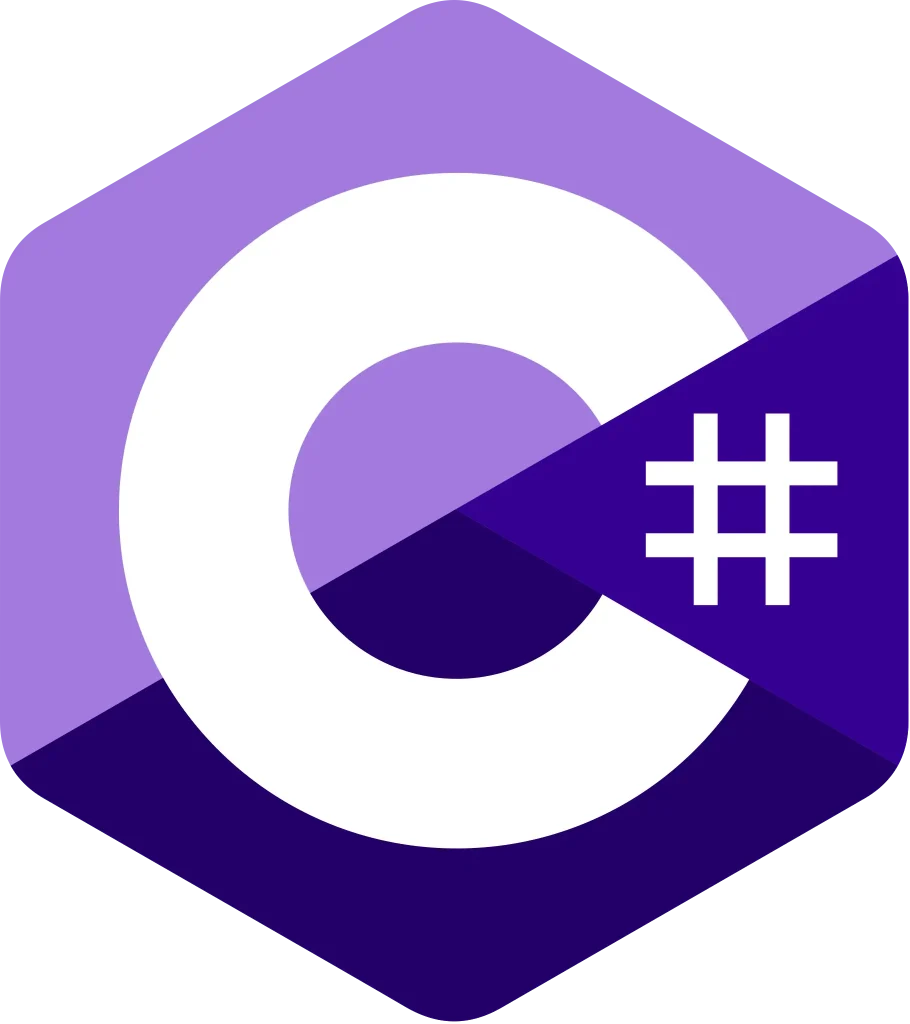
C# (pronounced “C Sharp”) is a versatile, object-oriented programming language developed by Microsoft. It’s part of the .NET framework and is used to develop a wide range of applications, including web applications.
In web development, C# is primarily used on the server side or backend, where it manages database connections, server-side logic, and the overall functionality of web applications.
Role of C# in Backend Development
C# plays a crucial role in the development of dynamic, scalable, and secure web applications. It’s used to create the logic that runs on the server, processing requests from the client (browser), interacting with databases, and generating the appropriate responses.
C# web programming langugage is often used with ASP.NET, a powerful framework for building web applications and services, making it a comprehensive solution for backend development.
Key Features of C#
- Object-Oriented: C# is an object-oriented language, which means it supports concepts like inheritance, polymorphism, and encapsulation. This makes the code more modular, reusable, and easy to manage.
- Type-Safe: C# is type-safe, meaning it ensures type compatibility. This reduces errors and improves the reliability and stability of web applications.
- Interoperability: C# can interact with components written in other languages, offering great flexibility in integrating with existing systems and libraries.
- Rich Library Support: The .NET framework provides a vast array of libraries and APIs for various functionalities, including database access, file operations, and network communications.
- Integrated Development Environment (IDE): C# benefits from robust development tools, primarily Visual Studio, which offers powerful debugging, code completion, and project management features.
Benefits of Using C# for Web Development
- Performance: C# and the .NET framework are optimized for performance. Advanced features like just-in-time compilation and garbage collection contribute to efficient application execution.
- Security: C# and ASP.NET offer several built-in security features, such as validation controls and encryption libraries, making web applications secure against common vulnerabilities.
- Scalability: Applications written in C# are easily scalable, making it suitable for projects ranging from small websites to large, enterprise-level applications.
- Community and Documentation: Being a language developed by Microsoft, C# has extensive documentation and a large community of developers. This provides ample resources for learning and troubleshooting.
- Cross-Platform Development: With the introduction of .NET Core, C# applications can now be developed and deployed on Linux and macOS in addition to Windows, broadening its reach and utility.
9. Go (Golang)

Golang, or Go, is an open-source web programming language created by Google. It’s designed for simplicity, efficiency, and reliability. Golang is increasingly popular for backend web development, thanks to its ability to handle high-performance and scalable web applications.
Its straightforward syntax and powerful standard library make it a great choice for building robust server-side applications.
Golang’s Role in Backend Development
In backend development, Golang’s role is to manage server-side logic, database interactions, and communication between the server and client-side applications. It’s well-suited for developing APIs, microservices, and large distributed systems.
Golang’s efficient concurrency model and fast execution make it ideal for tasks that require high performance, such as real-time applications and data processing.
Key Features of Golang
- Simplicity: Golang’s syntax is clean and easy to understand, making it accessible for beginners and efficient for experienced developers.
- Concurrency: One of Golang’s standout features is its built-in support for concurrent programming, enabling applications to perform multiple tasks simultaneously and efficiently.
- Performance: Golang compiles to machine code, which means it runs directly on the hardware without a virtual machine, leading to faster execution of applications.
- Strong Standard Library: It comes with a comprehensive standard library that provides a wide range of functionalities, including HTTP server and client packages, making it easy to build web applications.
- Garbage Collection: Golang includes an efficient garbage collector that automatically frees unused memory, helping manage memory allocation and reduce memory leaks.
Benefits of Using Golang for Backend Development
- Scalability: Golang’s concurrency model, along with its efficient use of resources, makes it highly scalable, perfect for applications that need to serve millions of users.
- Fast Development Cycle: The simplicity of the language, along with the powerful standard library and tooling, allows for a rapid development cycle, from writing the code to deploying applications.
- Reliability: Golang’s strong type system and compilation step help catch errors early in the development process, making applications more reliable and maintainable.
- Cross-Platform Development: Golang supports cross-platform development, allowing developers to compile applications for different operating systems (Windows, macOS, Linux) from the same codebase.
- Growing Community and Resources: Although relatively new, Golang has a rapidly growing community and a wealth of learning resources, libraries, and tools available for developers.
Also Read: Web Developer Job Description 2025 (Roles and Responsibilities)
Emerging and Niche Website Development Languages
Certain web programming languages have emerged to address specific challenges and needs, often filling niches that more established languages struggle with. Two such languages that have gained significant attention for their unique benefits are Rust and TypeScript.
1. Rust
Rust is a system programming language focused on safety, speed, and concurrency. It aims to provide memory safety without using a garbage collector, making it an excellent choice for high-performance applications where safety and efficiency are critical.
Safety: One of the hallmark features of Rust is its emphasis on safety, particularly memory safety. Rust achieves this through its ownership model, which ensures that each piece of data has a clear owner and enforces rules at compile time to prevent data races and invalid memory access.
This makes Rust a strong candidate for systems programming and applications where security and reliability are paramount.
Speed: Rust offers performance comparable to that of C and C++, making it suitable for performance-critical applications. Its efficient handling of memory and concurrency allows developers to write fast, low-level code without the traditional safety trade-offs.
Web Assembly Projects: Rust is increasingly used with WebAssembly (Wasm), enabling developers to run high-performance web applications in the browser. Rust’s performance characteristics and safety features make it an ideal language for compiling to WebAssembly, offering a way to build fast, secure, and portable web applications.
2. TypeScript
TypeScript is a superset of JavaScript that adds static type checking to the language. Developed by Microsoft, TypeScript is designed to address the scalability challenges of working with large JavaScript codebases, making it easier to manage and maintain complex applications.
Static Typing: The key feature of TypeScript is its static type system, which allows developers to specify types for variables, functions, and properties. This helps catch errors early in the development process, during compilation, rather than at runtime. Static typing also improves code readability and maintainability, making it easier for developers to understand and work with large codebases.
JavaScript Projects: TypeScript is fully compatible with JavaScript, meaning any valid JavaScript code is also valid TypeScript. This allows developers to gradually adopt TypeScript in existing JavaScript projects, adding types to parts of their codebase incrementally.
TypeScript compiles down to plain JavaScript, ensuring that TypeScript applications can run anywhere JavaScript does.
Benefits: By providing static typing, TypeScript enhances developer productivity, improves code quality, and makes it easier to refactor and maintain large and complex applications. Its strong tooling support, including intelligent code completion and error detection, further boosts development efficiency.
Also Read: Is Web Development a Good Career? 2025 Guide
Factors to Consider When Choosing Best Web Development Language
When selecting a web development language for a project, it’s essential to consider various factors that can influence both the immediate and long-term success of the project. These factors ensure that the chosen language aligns with the project’s goals, team skills, and future growth.
1. Project Requirements and Scalability
- Specific Needs: The nature of your project—whether it’s a simple static website, a complex web application, or something that requires real-time data processing—significantly influences the choice of language. Some languages and their frameworks are better suited for certain types of tasks than others.
- Scalability: Consider how easy it is to scale applications built in the language, both in terms of handling increased load and in adding new features. Languages and frameworks that support modular, service-oriented architectures can simplify scaling and maintenance.
2. Community Support and Ecosystem
- Libraries and Frameworks: A rich ecosystem of libraries and frameworks can accelerate development by providing pre-built functions and templates for common tasks. This can reduce the time and effort required to develop new features and solve problems.
- Community Support: A strong, active community can be a valuable resource for developers. Communities contribute to a vast pool of knowledge, including tutorials, forums, and third-party tools, which can help resolve issues and improve skills.
3. Learning Curve and Developer Productivity
- Ease of Learning: Some languages are more beginner-friendly than others, offering simpler syntax and more intuitive concepts, which can be crucial for teams with less experience or when rapid development is needed.
- Developer Productivity: Consider how the language and its tools affect developer productivity. Features like code completion, error detection, and efficient debugging can significantly speed up development and reduce the number of bugs.
4. Performance and Hosting Considerations
- Execution Speed: The performance of the language can affect the responsiveness and efficiency of the application. High-performance languages may be necessary for compute-intensive applications or when optimizing for speed is crucial.
- Hosting Environment: Some languages may have specific requirements or are more naturally suited to certain hosting environments, which can affect hosting costs and deployment complexity. For instance, deploying and running a Node.js application can be different from a PHP-based application in terms of server setup and management.

Evolution of Web Programming Languages
The evolution of web development languages is a fascinating journey that reflects the changing needs and complexities of Internet technology. From simple, static web pages to dynamic, interactive web applications, the landscape of web development has transformed significantly.
1. Early Days: Static Web Pages
HTML (HyperText Markup Language): Introduced in the early 1990s, HTML was the foundation of the web, allowing developers to create static web pages. It provided a simple way to structure text and images on a webpage.
2. Adding Style and Design
CSS (Cascading Style Sheets): As the web became more popular, there was a growing need for more stylized and visually appealing web pages. Introduced in 1996, CSS allowed developers to separate content from design, providing the tools to set fonts, colors, layouts, and more.
3. Introducing Interactivity
JavaScript: To make web pages more interactive, JavaScript was introduced in 1995. It was the first scripting language that could be executed in web browsers, allowing for client-side interactions without the need to reload the page. This marked the beginning of dynamic web content.
4. Server-side Scripting
PHP: In the mid-1990s, PHP was created to enhance web pages through server-side scripting. It enabled dynamic content that could respond to user inputs, access databases, and create personalized web experiences.
ASP (Active Server Pages): Microsoft introduced ASP in the late 1990s as a tool for building dynamic web applications that could interact with databases and other server-side technologies.
5. The Rise of Full-stack Development
MEAN and MERN Stacks: The 2000s saw the rise of full-stack development, with technologies like MongoDB, Express.js, AngularJS/React, and Node.js (MEAN/MERN stacks) allowing developers to use JavaScript for both front-end and back-end development. This unified approach streamlined web development processes.
6. Modern Web Development
Frameworks and Libraries: The complexity of web applications continued to grow, leading to the development of various frameworks and libraries (e.g., React, Angular, Vue for front-end; Django, Ruby on Rails, Laravel for back-end) to simplify development, improve efficiency, and enhance user experiences.
Progressive Web Apps (PWAs) and Single Page Applications (SPAs): These technologies represent the latest evolution in web development, offering app-like experiences within web browsers, pushing the boundaries of what web applications can do.
7. Future Directions
WebAssembly: As we move forward, technologies like WebAssembly allow languages other than JavaScript (e.g., C, C++, Rust) to run in the browser, potentially unlocking new levels of performance and expanding the possibilities of web development.
Easy-to-Learn Web Development Languages
It’s worth considering which web development coding languages offer the quickest paths to proficiency. The easiest languages to understand include:
- HTML
- Python
- JavaScript
- PHP
- Java
FAQs Related to Web Development Languages
HTML and CSS are the best starting points for beginners, as they are fundamental to web development, relatively easy to learn, and provide immediate visual feedback. JavaScript is another essential language that adds interactivity to web pages, making it a crucial skill for front-end development. You can learn all these with an online web development course.
Python is predominantly used for back-end development, especially with frameworks like Django and Flask. For front-end development, technologies like HTML, CSS, and JavaScript are necessary. However, Python can indirectly influence front-end development through server-side templates and web APIs.
No, JavaScript is not limited to front-end development. With the introduction of Node.js, JavaScript can also be used for back-end development, allowing developers to write server-side code in JavaScript. This has made JavaScript a popular choice for full-stack development.
Learning a web development framework is highly important as it can significantly speed up the development process, enforce best practices, and solve common problems more efficiently. Frameworks like React (JavaScript), Django (Python), and Ruby on Rails (Ruby) offer pre-written code, libraries, and tools that help in rapid application development.
Static websites consist of fixed content where each webpage is coded in HTML and displays the same information to every visitor. Dynamic websites, on the other hand, generate content in real-time based on user interactions or other inputs, requiring server-side processing and languages like PHP, Python, or JavaScript (with Node.js).
Yes, C# is widely used for web development, particularly on the back-end with the ASP.NET framework. It allows for building dynamic web applications, services, and APIs. C# is known for its performance, security features, and integration with the .NET ecosystem.
Full-stack development involves working on both the front-end (client-side) and the back-end (server-side) of web applications. Full-stack developers have the skills to create a complete web application from start to finish, encompassing user interface design, business logic, database management, and server configuration.
Learning SQL (Structured Query Language) is important for web development, especially for back-end and full-stack developers. SQL is used to interact with databases to insert, query, update, and delete data, which is essential for dynamic web applications that rely on persistent data storage.
CSS (Cascading Style Sheets) is used for styling web pages. It controls the layout, color, fonts, and overall appearance of web content, allowing developers to create visually appealing and user-friendly interfaces.
Choosing the right web development language depends on several factors, including the project’s specific requirements, the development team’s expertise, the desired performance and scalability, and the ecosystem and community support for the language. Consideration of these factors will help you select the most suitable language(s) for your project.
While it’s possible to specialize in one language, learning multiple web programming languages can be beneficial, as it increases your versatility and job prospects. Full-stack developers, in particular, benefit from knowing a variety of languages for both front-end and back-end development, such as JavaScript for the front end and Python or Node.js for the back end.
JavaScript enhances website interactivity by allowing developers to implement dynamic content updates, interactive maps, animated graphics, scrolling effects, and form validations without reloading the page. This leads to a more engaging and seamless user experience.
Progressive Web Apps (PWAs) are web applications that use modern web capabilities to deliver an app-like experience to users. They are built using standard web technologies, including HTML, CSS, and JavaScript, and offer features like offline support, push notifications, and fast load times.
Yes, web development languages, especially JavaScript, can be used for mobile app development through frameworks like React Native or tools like Cordova. These technologies allow developers to write code once and deploy it as a mobile app across multiple platforms (iOS and Android).
TypeScript introduces static typing to JavaScript, helping to catch errors and bugs during development, which is especially beneficial for large-scale applications. It provides better documentation through types and makes the codebase easier to refactor and maintain, leading to higher code quality and developer productivity.
PHP is popular for server-side scripting due to its ease of use, wide support across hosting providers, integration with various databases, and a rich ecosystem of frameworks and libraries. It’s particularly well-suited for developing dynamic web pages and applications that require database interaction.
Microservices are a software architecture style that structures an application as a collection of loosely coupled services, which implement specific business functionalities. This architecture influences the choice of web development languages by enabling the use of different languages best suited for each service, depending on its requirements and the team’s expertise.
Security considerations include validating and sanitizing input data to prevent injections, implementing secure authentication and authorization, using HTTPS, protecting against cross-site scripting (XSS) and cross-site request forgery (CSRF), and regularly updating libraries and frameworks to patch vulnerabilities.
Developers can stay updated by following tech blogs, participating in developer forums and communities, attending webinars and conferences, contributing to open-source projects, and taking online courses that cover the latest trends and best practices in web development.
Conclusion
Whether you are an established coder or just beginning to look into the industry, learning a new website development language is one of the best ways to advance your programming career. No matter which route you choose, one point is certain: there is no better time to pick up a new skill and kickstart your programming career.
Hope this list of the most in-demand web programming languages will help you begin your journey!
Read more blogs:



